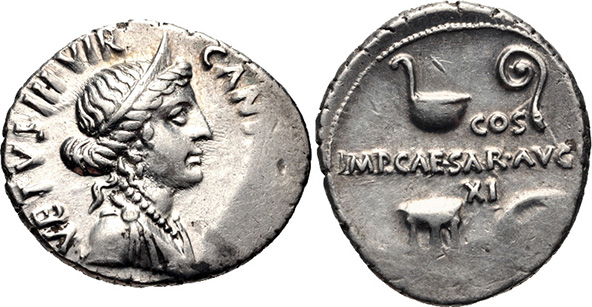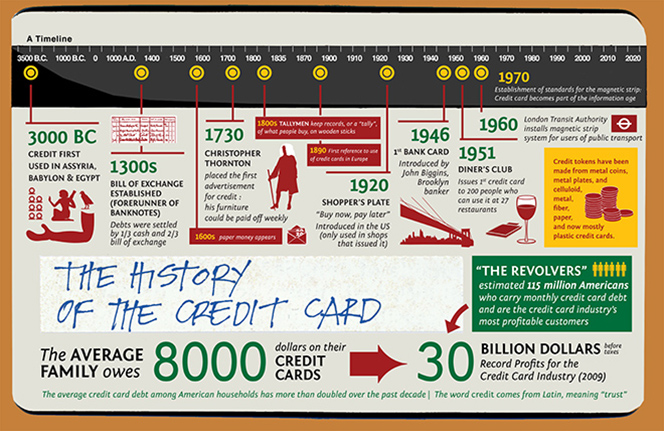The Evolution of Money: From Shells to Bitcoin

The guys at Structured Settlement Cash (SSC) are the latest to take on the arduous task of tracking the evolution of money down the ages, just so the rest of us can learn how our forebears transacted with one another when they were not busy bashing each other over the head. The end result is an amazing infographic, which follows the money trail all the way back to around 10,000 years ago.
The SSC infographic is not exactly the first attempt to visualize the history of money, nor will it be the last. Just within the past year or so, a couple of other excellent pieces of graphic art independently traced the origins of credit cards all the way back to 3,000 BC. So I thought I’d show you the three infographics in one place — I had fun with them and so might you.
From Rocks to Holograms
First, let’s take a look at the SSC piece. Barter — the practice of trading one type of commodities for another — existed long before money ever showed up, we are reminded. People would exchange things like salt, seeds, weapons, food, cattle, tools, clothes and pretty much anything else, based on their perception of the exchanged items’ comparative value. By around 10,000 years ago, livestock such as camels, sheep, and cows, as well as grain were commonly accepted currency. Then people in Central Asia took the idea a step further:
Around 5,000 years ago, grain became a standardized currency in Mesopotamia, with the “shekel” being the standard measurement of weight. The value of a “shekel” of grain later became a “shekel” worth of bronze, copper, and silver. All currency at this time was a method of simplifying the barter process to ensure efficiency. Currency eventually evolved to make trading easier.
In North America, the preferred type of currency were shells and beads. The Chinese, too, adopted shells as currency around 1,200 years ago, due to their rarity, as did other societies. Eventually, however, precious metals took over:
Sometime between 1000 to 600 years ago, the Chinese society was credited with producing the world’s first coins made from non-precious metals. Around 700 BC, production of silver and gold coins were underway in ancient Lydia (currently modern-day Turkey). Production of gold and silver coins also originated around the same time in Greek cities on the coast, and decorated with printed images of gods, animals, and emperors.
Leather money was the precursor of the contemporary paper variety and, by 118 BC, had become “a durable and efficient means of currency” in China, we learn. Paper money were introduced in China in 806 AD, but did not become widely accepted until 960 AD, we are told.
Then the authors breeze through the history of credit cards, but the other two infographics have done a much better job at dealing with this topic. Finally, we are presented with the modern iterations of currency, which exist solely in non-physical form. The authors have chosen PayPal and Bitcoin as the standard bearers of the new virtual money age, although, as regular readers know, this blogger is highly dubious about the merits of Bitcoin as a viable currency.
Here is the graph:

The History of Credit Cards
Now, as promised, here are two independent efforts at visualizing the evolution of the rectangular pieces of plastic most of us use in our daily transactions.
First, I’m giving you my personal favorite: Avid Trader‘s awesome infographic, which traces credit cards’ beginnings all the way back to 3,000 BC when “credit [was] first used in Assyria, Babylon & Egypt”. In 1730, we learn, “Christopher Thornton placed the first advertisement for credit: his furniture could be paid off weekly”. And the Avid Trader guys just couldn’t resist reminding us that card issuers made $30 billion in “record profits” in 2009. Here is the infographic:

Similarly to Avid Trader, Credit Donkey has traced the credit card’s ancestors all the way back to 3000 BC and to Assyria, Babylon and Egypt. Christopher Thornton’s furniture credit scheme is once again prominently featured, but the donkey guys aren’t just repeating what Avid Trader had already done. They’ve dug out invaluable pieces of credit history, such as the fact that the “[s]ocialist writer Edward Bellamy used the phrase “credit card” along with its concept in his Utopian novel, Looking Backward”. In case you are wondering, the novel in question was published in 1887 and the story was set in the distant year 2000. Then in the early 1900s, “[l]arge hotels and department stores issue paper cards to their important customers”. And on the story goes, as revealed in great detail in the graph below.

I’m sure there are many other worthy attempts to trace the history of money and credit and you are welcome to send them over.
Image credit: Wikimedia Commons.


